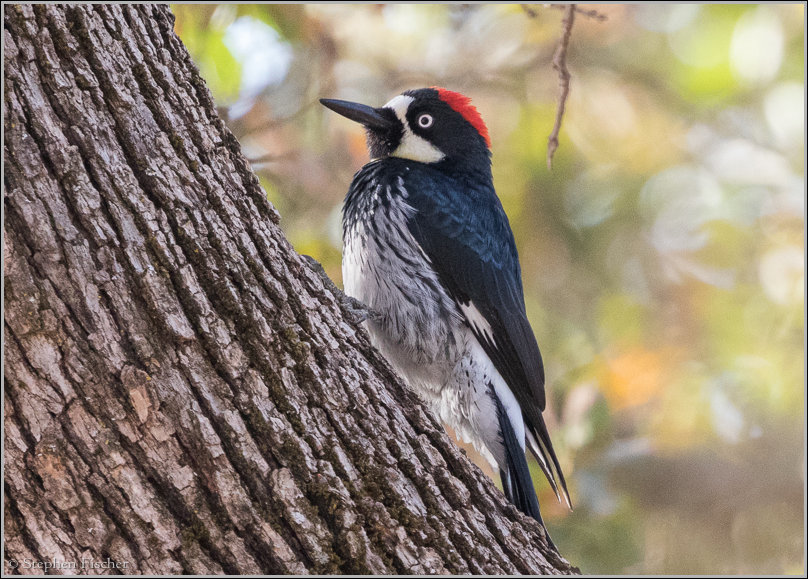
Now technically retired, he lives down the road from the reserve and comes by almost every day. In 1974, Walt Koenig arrived and has more or less been here ever since. Researchers Michael and Barbara MacRoberts launched the project in 1968 to learn more about the birds’ complex social structures. Generations of scientists have studied the birds at UC Berkeley’s Hastings Reserve. On hikes, you might hear their raucous “waka waka” calls and look up to see multiple woodpeckers flying out of a tree hole, like clowns tumbling out of a clown car. With their round white eyes and conical beaks, acorn woodpeckers provide the comic relief of the oak woodlands. (Illustration by Christopher Reiger) ACT II: “Waka waka” Reservation fasten colored bands to woodpecker legs to track individual birds and learn more about their complex social interaction. Researchers at the Hastings Natural History The woodpecker flies into the oak trees, out of sight. “Feed your children!” she admonishes, and then stretches out her arms and releases. She cups the animal in her hands and brings it close to her face. Winter hands the banded woodpecker to Horowitz. It’s a bit like a Shakespearean tragedy, with numerous contenders fighting for the throne once the king has passed on.

But as Eric Walters, principal investigator for the Hastings woodpecker research, says, “Cooperative doesn’t always mean they don’t have conflict.” When the last breeding female or male in one group dies, other birds fly in from miles away to become the new breeder. The offspring often stay with the group and help raise their parents’ young. They’re cooperative breeders, meaning that multiple female and male birds live together in one group, breeding with each other and laying eggs in the same nest. Acorn woodpeckers have one of the most complex social structures of any animal. The scientists here study the social interactions of these birds and need to be able to recognize each individual. “An unbanded adult woodpecker is useless to the data set,” Winter says. But here at Hastings, it’s especially important. It’s common for scientists to use color bands to track and study birds.

#Natural enrichment for acorn woodpecker code
Lastly, he ties to the woodpecker’s back a tiny computer chip that will transmit a unique code picked up by one of 50 base stations every time the bird flies overhead.įor more than 50 years, biologists have been researching acorn woodpeckers here at the Hastings Natural History Reservation, a UC Berkeley field station in the oaken hills of Carmel Valley, in one of the longest-running bird studies in North America. Holding it firmly but carefully, he measures the bird and then fastens four tiny bands around its legs in a distinct color pattern. Sitting cross-legged next to the blanket, Winter takes a bird out of the drawstring bag. While he was up in the tree, his assistants, Hannah Horowitz and Megan Massa, created a makeshift workstation by spreading a blanket on the forest floor. He places each bird in a cloth drawstring bag, puts the bags in his backpack, and rappels to the ground.

Now, steadying himself against the tree trunk with his legs-like a woodpecker using its tail-he sticks his arm into the cavity and removes two birds, one after the other. He ascended by rope until he was within reach of the cavity. He pulled on the fishing line until the bobber slipped into the hole, trapping the birds inside.

Early this morning, while the great horned owls were still hooting, he returned in the dark. Then he staked out the birds until nightfall to make sure that they’d entered the cavity. The round bobber is just slightly bigger than the entrance hole to an acorn woodpecker’s cavity and prevents the birds’ escape. First, he assembled the ambusher, a low-tech contraption consisting of fishing line and a bobber. He’s about to stick his arm into a tree hole, almost up to his elbow, to fish out an adult woodpecker. and he’s dangling from a rope halfway up a 45-foot-high oak tree. But one morning in June, biologist Russell Winter is hoping to get lucky. It might have beaten you to the woodpeckers, and you’ll pull out a well-fed snake instead of a bird. If you’re unlucky, there could be a gopher snake in there. You’ll definitely have to shove your arm into that cavity without being able to look inside. If you want to catch an acorn woodpecker, you’ll probably have to climb a tree at night while the woodpeckers are roosting in tree cavities. government work and is not subject to copyright in the United States.)/Rect/Subj(Text Box)/Subtype/FreeText/T(proyster2)/Type/Annot>


 0 kommentar(er)
0 kommentar(er)
